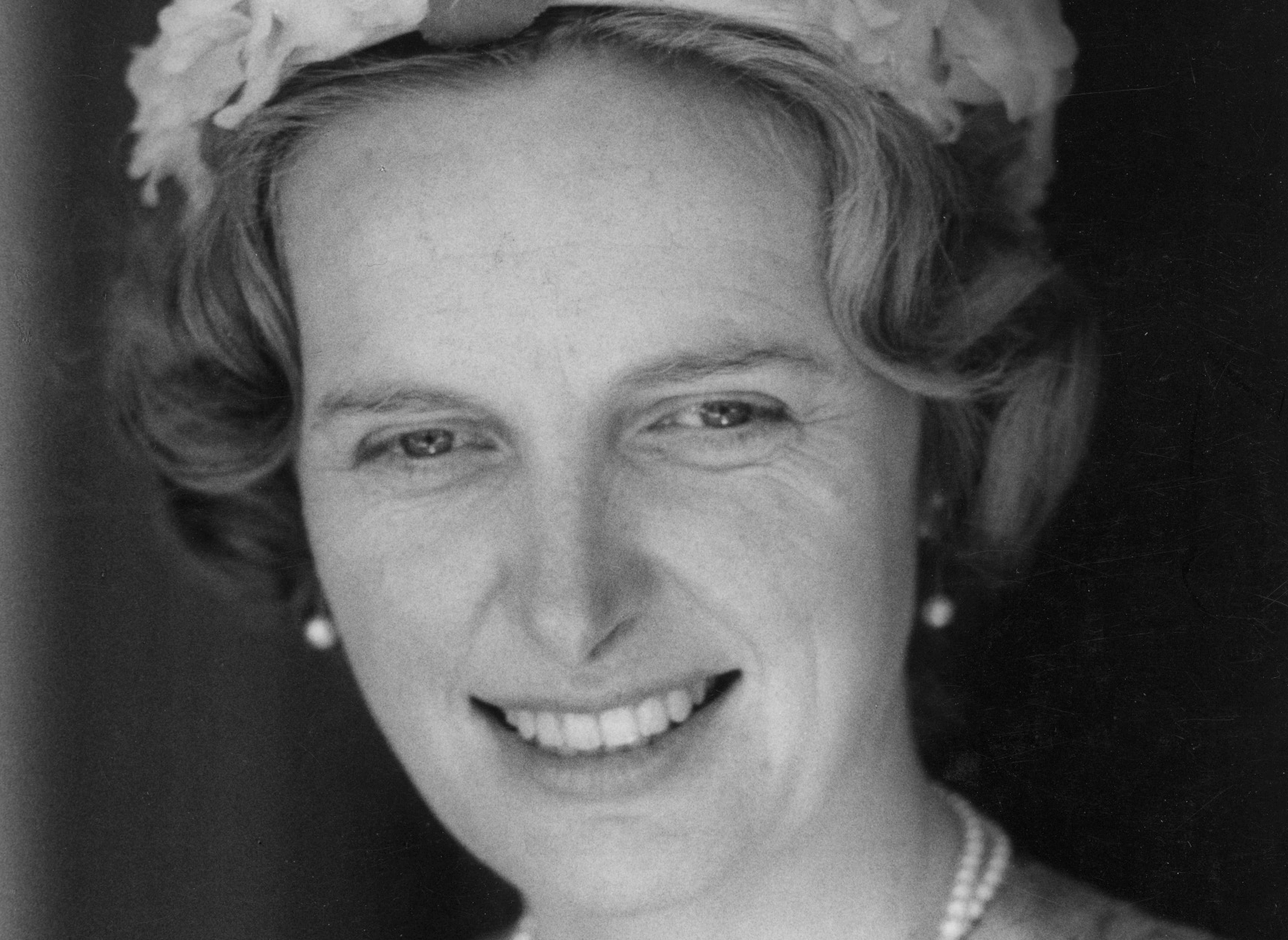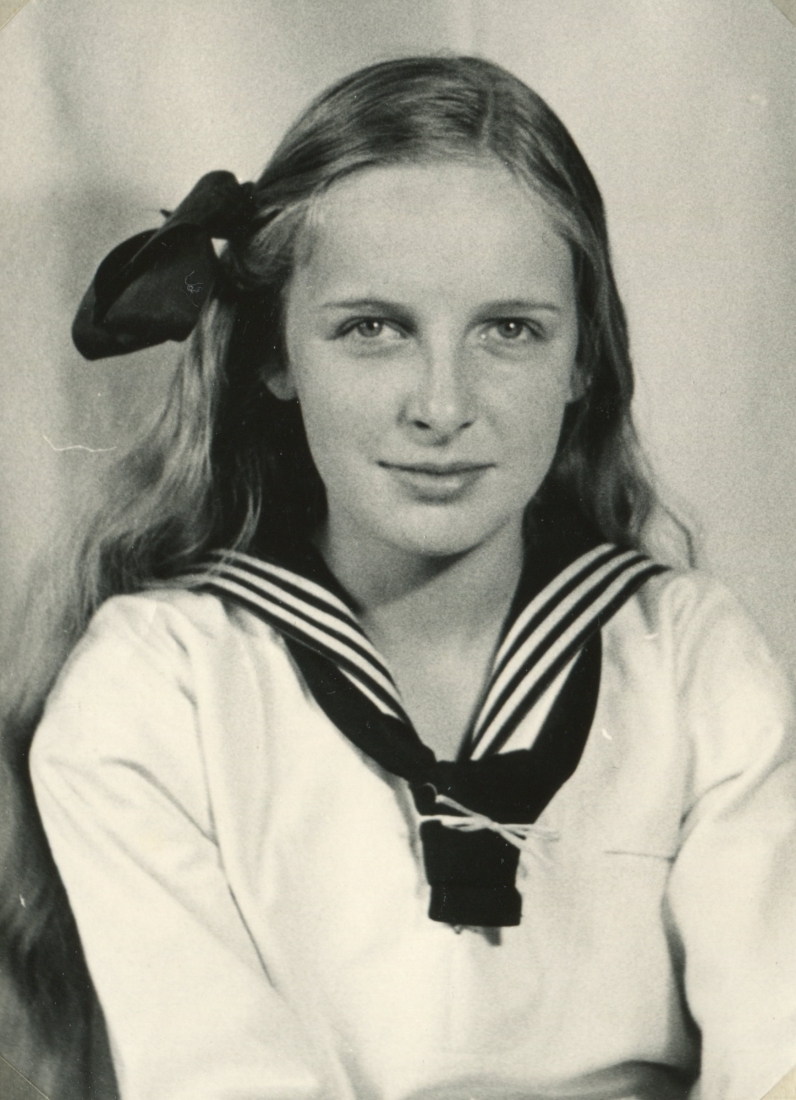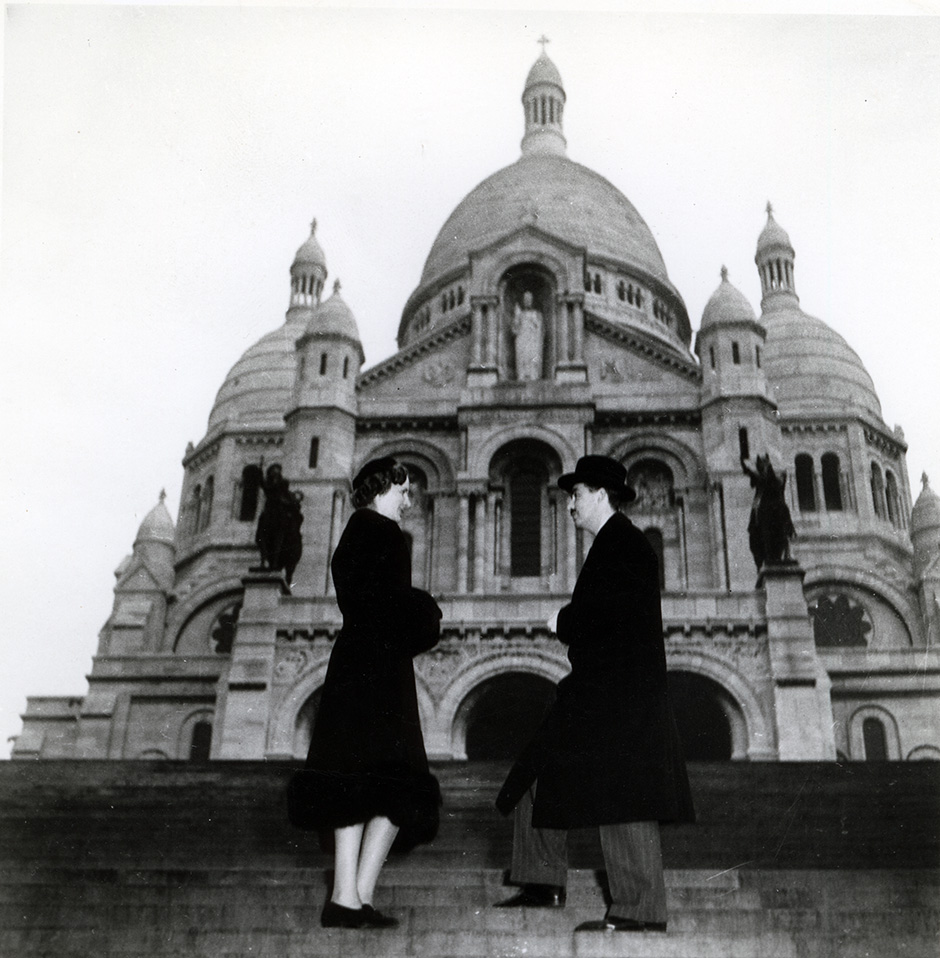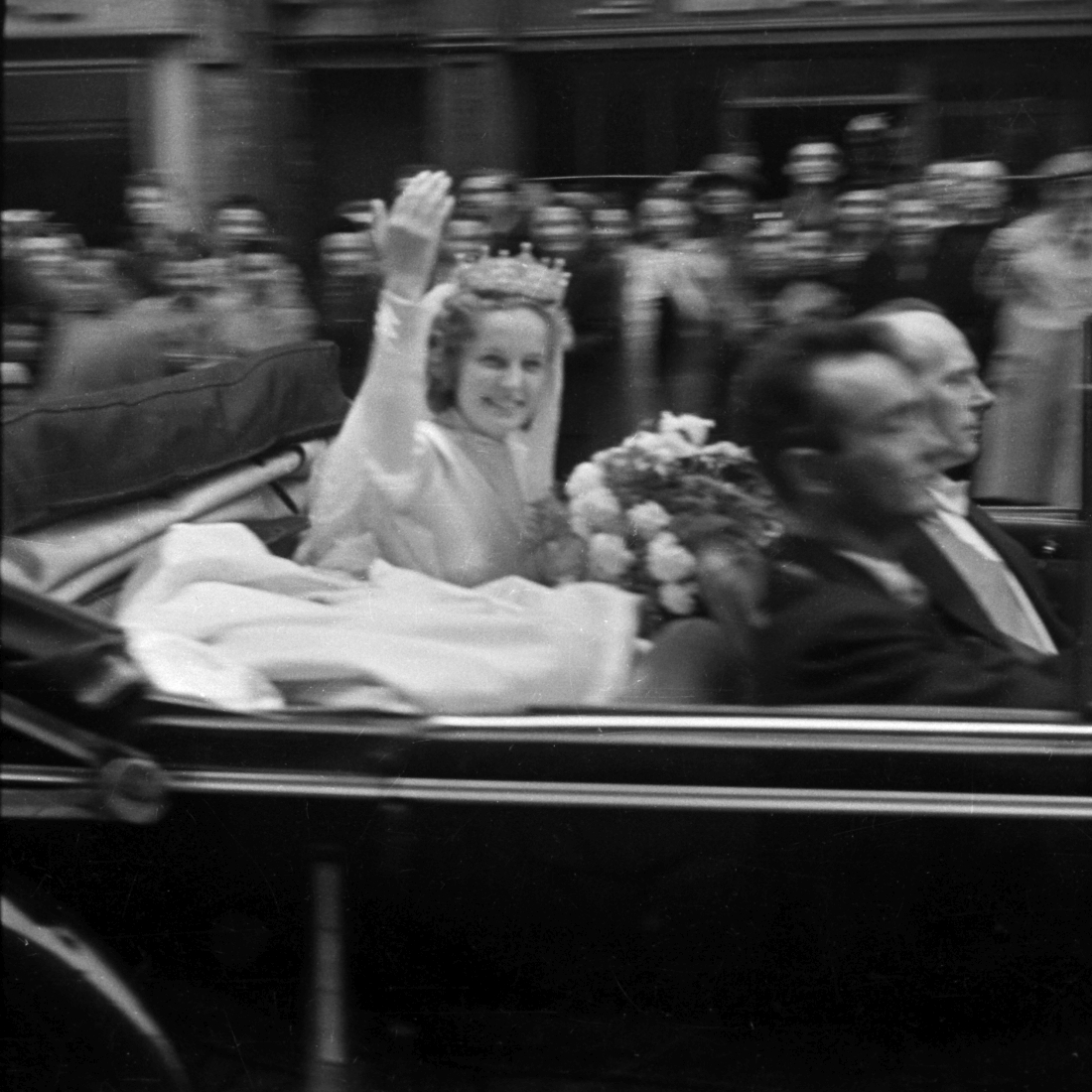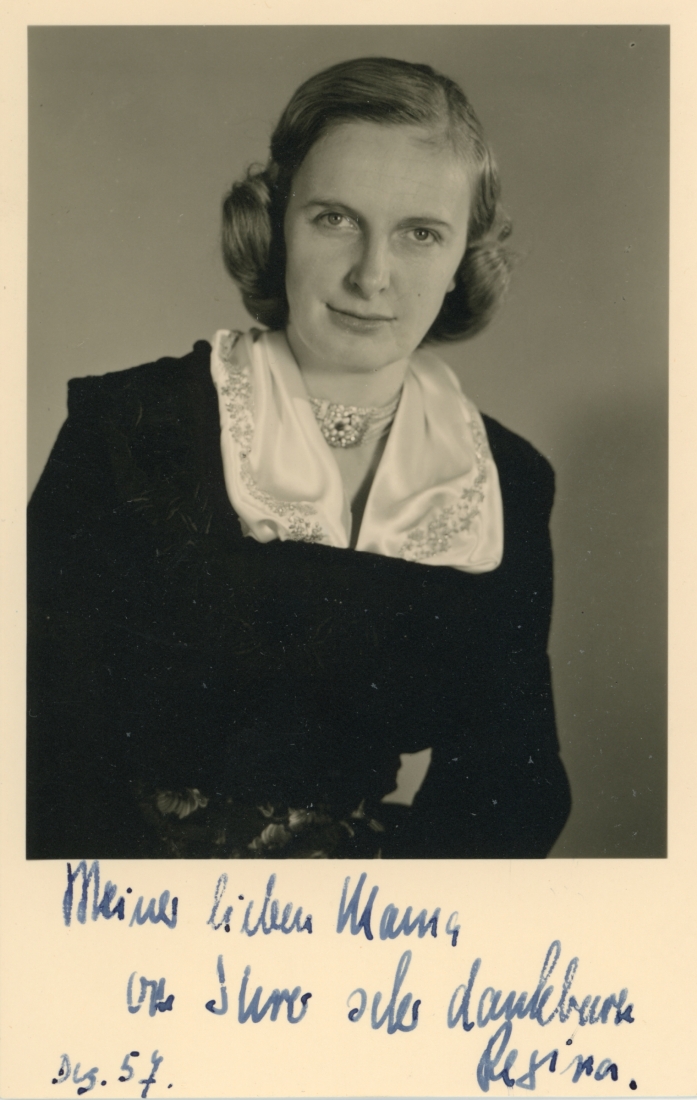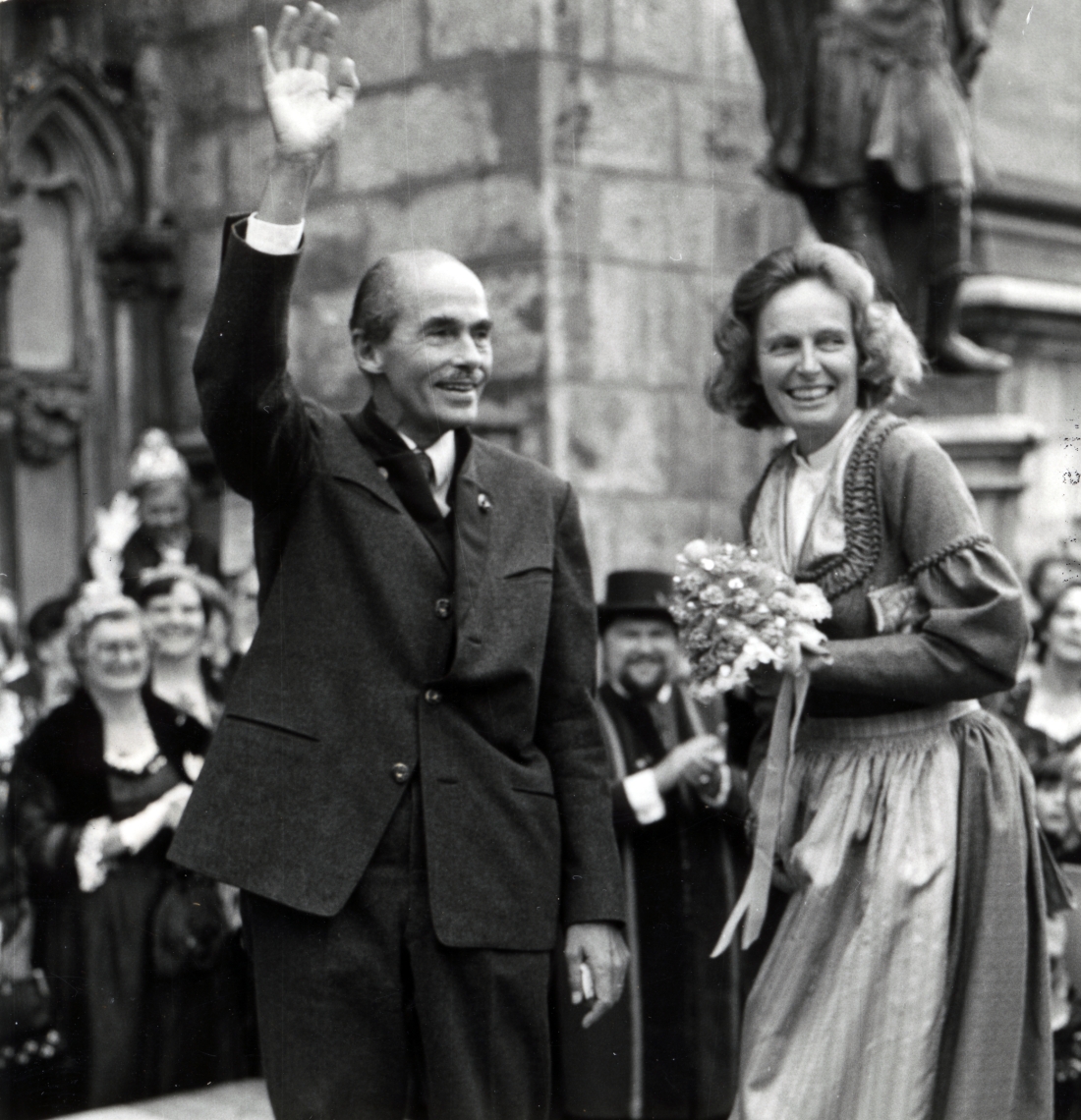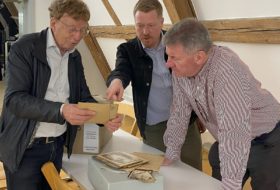As already reported on our website, 6 January 2025 is the 100th anniversary of the birth of Otto von Habsburg’s wife. To mark the occasion, our Foundation and the Meiningen Museum have jointly organised an exhibition entitled “Regina von Habsburg, Princess of Saxe-Meiningen” at Schloss Elisabethenburg in Meiningen. The family lived in part of this castle between the two world wars, and also in the nearby Veste Heldburg, which they also owned and which later lived in Regina’s memory as the scene of a happy, carefree childhood. The opening of the exhibition took place on 28 November 2024.
We presented the personality and life of Princess Regina of Saxe-Meiningen in the exhibition in broad outlines, highlighting a number of important aspects – in part owing to the limited space available, and in part due to the fact that the subject has been little researched so far. This time we do not publish a detailed biography of her, but the documents in the Foundation’s archives – correspondence between Regina and Otto and Queen Zita – provide an interesting insight into their relationship, the personality of the young bride and the position of the newly “married-in” Regina in the Habsburg family.
Regina of Saxe-Meiningen, c.1937
(Photo: Archiv Stefan Rose)
As mentioned in an earlier article, Otto and Regina were engaged on Christmas 1950 in Seeheim, near Lake Starnberg, in a house built at the time by Regina’s mother, Countess Klara von Korff Schmising-Kerssenbrock. The joyous event was preceded by a series of family tragedies: in May 1940, first-born son Anton Ulrich (1919-1940) was killed on the French front, and in August 1945 the Soviet secret service deported the father, Prince George III of Saxe-Meiningen, who died in a prisoner-of-war camp hospital in Cherepovec, Russia, in January 1946. The family was stripped of its assets, and Klara was forced to flee Thuringia with her two children, Friedrich Alfred (1921-1997) and Regina. They lived for a time in Bamberg. Regina studied philosophy and theology, while her brother Fritzi chose the priestly vocation and entered the seminary, being ordained in 1950. Klara tried to make a new home for herself and her daughter in Bavaria. But Regina, who had meanwhile spent two years at the Sacré Coeur in Munich and completed a course in social work, lived here only briefly, marrying Otto von Habsburg in 1951. The couple’s first home together was in Clairefontaine-en-Yvelines, not far from Paris.
Regina of Saxe-Meiningen and Otto Habsburg, 1951, Sacré Coeur, Paris
(Photo: Otto von Habsburg Foundation)
The letter we present above was sent by Regina to a certain “Aunt Putzi”, dated 17 March 1952,[1] less than a year after their grand wedding in Nancy. From the text of the letter, a copy of which has been preserved by the family, we can deduce that Otto’s mother was already planning to retire to a Benedictine monastery towards the end of her life.
Levél_Regina Tante Putzinak Zitáról 19520317
It is not difficult to identify who “Aunt Putzi” was, given the family background, to whom Regina wrote about such a serious issue with great care, consideration, sensitivity, love and respect – moreover, humility.[2] Three of Zita’s sisters, born of the second marriage of Prince Robert of Bourbon-Parma, to the Portuguese Infanta Maria Antonia, chose the monastic vocation: Maria Adelaide (1885-1959), Francesca (1890-1978) and Maria Antonia (1895-1977) were all Benedictine nuns. All of them lived in the Benedictine convent of St Cecilia of Solesmes (Sarthe, France) until their death. Adelaide took the monastic name of Maria Benedicta and lived at one time in the Benedictine convent on the Isle of Wight, where Zita spent almost a year after completing her studies, at a time when the convent was not allowed to function on French territory.[3] Adelaide (i.e. Sister Maria Benedicta) died as abbess of the convent of Solesmes in 1959. The letter is certainly addressed to her, the superior of the convent, since Regina says: “You have a say in this matter“. It is possible that Zita might have joined three of her sisters in the Benedictine convent, but no concrete details have yet been found. Aunt Cicca, mentioned at the end of the letter, can be identified as Francesca, another of Zita’s sisters.
Regina of Saxe-Meiningen at her wedding, 10 May 1951, Nancy
(Photo: Jean-Jacques Puton)
Regina’s letter raises a serious question: it seems that the exiled Empress and Queen, who had been a widow for almost thirty years, was considering how to continue her life, and that she had a different vision than her children would have thought appropriate. The information from Otto’s sisters and the conclusions drawn from it, the situation that emerges from the letter and the reflections on it, are only one aspect of the extent to which Regina and Otto and their sisters considered Zita’s health and the monastic lifestyle to be compatible. In lines addressed to her husband’s aunt, the writer takes stock of the consequences that Zita’s planned move would have on the family’s life. Regina and her brothers-in-law and sisters-in-law believe that the former Empress and mother-in-law, who has led a turbulent, one might say troubled, life, could still pass on many values to the “children”. In addition, they feel that it is of paramount importance that “she is also the only one who can pass on to us children (fifteen so far)[4] Papa’s legacy, which is an absolute guide for our lives.”
Regina presents all this to the abbess-aunt in a respectful and modest way. Even the familiar address (Tante = aunt) indicates that Regina is expressing her views on behalf of herself and Zita’s children as a true member of the family. There are many signs of her acceptance into the Habsburg family, and not only in this case: Zita herself writes to her, sometimes in a very affectionate, warm tone of voice, which shows her appreciation. Two examples are given below to illustrate this.
A week before Regina sent her letter to Aunt Putzi, Zita had written a short message to Regina from her home in Tuxedo (USA) on 10 March 1952[5]:
“Dear Regina!
Otto was with us for 24 hours and we enjoyed his short stay very much. In any case, I must add that without you, Otto is only half Otto. So we missed you very much!”
(This letter explains why Otto did not write to Aunt Putzi: he was on a lecture tour in the United States at the time.)
HOAL720
Zita writes to Regina in a somewhat later letter from Berg, dated 27 February 1953[6]:
“To what you say about the joy of the elderly Austrians to see me again and that I am the true and real Mother of the Country[7], I would like to interpose that I am the true and real Grandmother of the Country, the true and real Mother of the Country since May 10, 1951, is you, my dear Regina. And every day, from the bottom of my heart, I thank God for having chosen such a great and beloved Mother of my beloved countries. You are the one!!!! … You and Otto are the present and the future! And when the baby comes, even more so! May God bless you a thousand times over, so that you can make the future much happier than the past.”[8]
Autograph photo postcard from Regina to Zita, 1957
(Photo: Otto von Habsburg Foundation)
Many photographs show that the relationship between the two women, Zita and Regina, remained intimate in later years. This is certainly based on Regina’s modest, respectful and loving, supportive attitude towards both her husband and his mother. She also wrote to Aunt Putzi: “I respect and love Mama with all my heart, and I am very grateful to God that I could get to know her.”
Throughout their life together, Regina supported and assisted Otto’s activities, wisely, staying in the background, but fully aware of her task and the importance of it. She accompanied her husband to countless places in the world, standing by his side as a worthy companion, even in difficult situations.[9]
HOAL721
At the opening of the exhibition in Meiningen to celebrate the centenary of Regina’s birth, one of her daughters, Gabriela von Habsburg, remembered her mother in a personal speech:
“My father has been the subject of endless speeches, hundreds of anecdotes and fascinating stories. My mother, however, was an equally prominent figure, but she was always modestly in the background, so she was almost never spoken of separately, just for herself.
It was a great division of labour between my parents. My father was the head of the Habsburg family, but my mother was the centre and soul of our family.
My mother was a deeply religious person. She lived the Catholic religion in a very convincing way.
The most important thing was to approach everything with love and cheerfulness. She found the good in everything and everyone. She never said anything bad about anyone. My father laughed and said: according to her, even the devil is hardworking!
She had an incredible sense of humour and we always had a good laugh together. Anyway, she made a lot of jokes, but never at the expense of others. And that’s not easy, because the best jokes are usually the ones about other people’s weaknesses.
She was the best role model we could have ever had! She had a deep faith, was full of cheerfulness and did everything with love. My son once said to me as a boy: if Omama is one’s grandmother, one cannot become a bad person.”
Regina’s letter of 1952 reflects the same loving mindset, respect and appreciation for others, and good intentions. Her deep faith enabled her to readily submit her clear-sighted thoughts and intentions to God’s will, as she did at the time of her death in 2009. We will certainly discover many more interesting details of her life, as she lived through the turning points of the 20th century, through great losses and joys, willingly accepting her place in the world. We might add that the photographs in our Foundation’s archives show the serenity that helped her through the difficulties and joyful events of her life, and set an example not only for her children and grandchildren, but also for the people of today.
Eszter Fábry
The Silver Wedding of Otto and Regina, 1976, Mariazell
(Photo: Otto von Habsburg Foundation)
[1] [1] HOAL I-2-a-Habsburg Regina (Clairefontaine 17 March 1952). Records are being sorted.
[2] Aunt “Putzi” was the nickname of Queen Zita’s eldest sister. Princess Maria de las Nieves Adelaide Erika Pia Antonia Pia Borbon-Parmai was born on 5 August 1885 in Rorschach (Sankt Gallen), Switzerland, in the Wartegg castle. She was a Benedictine nun, first in France as Mother Marie Bénédicte, at Saint Cecilia Abbey, Rydes, Isle of Wight, Great Britain, and then as Prioress at Saint Cecilia Abbey, Solesmes, France, until her death on 6 February 1959.
[3] The monks were forced to leave the Benedictine Abbey of Solesmes and emigrate to Britain because of the anti-clerical law which came into force in France in 1901. They were only allowed to return in 1922.
[4] Regina is thinking of those already married and of those who have not yet married but have been chosen: Otto and herself; Adelheid (she never married); Robert and Princess Margherita di Savoia-Aosta (⚭ 1953); Felix and Princess Anna-Eugénie von Arenberg (⚭ 1952); Charles Louis and Princess Jolande de Ligne (⚭ 1950); to Rudolph and Princess Xenia Chernichev-Bezobrazov (⚭ 1953); to Charlotte (she married later); and to Elisabeth and Prince Heinrich Karl of Liechtenstein (⚭ 1949). By this time Zita had already had a grandchild.
[5] HOAL I-2-a-Habsburg-Lotaringiai Zita (Tuxedo, 10 March 1952). Records are being sorted.
[6] In the Bourbon- Parma ducal family, the solidarity and mutual support of each other was already evident during the First World War and later during the years of exile. Another testimony to this is the fact that in the letters of Zita from this period, which are still being processed and which we have in our archives and which are addressed to Regina and Otto, Berg is mentioned several times as the place of date. Zita’s younger brother Felix (1873-1970) was married to Grand Duchess Charlotte of Luxembourg (1896-1985), so it is understandable that at this time Zita would have been living with her brother’s family in the Grand Ducal Palace of Berg in Luxembourg.
[7] Landesmutter: the word means mistress, ruler, regent. For the sake of play on words, we have kept the translation “Landesgrossmutter” to reflect the tone of the original letter.
[8] HOAL I-2-a-Habsburg-Lotaringiai Zita (Berg, 27 February 1953). Otto and Regina’s first child, Andrea Maria, was born in Würzburg on 30 May 1953.
[9] Our archives contain a letter from Otto’s sister Adelheid to Regina: HOAL I-2-a-Habsburg Adelheid (Pöcking, 5 June 1967). In it, she refers to an unpleasant incident from the time when Otto and Regina were finally allowed to enter Austria, and during one of their visits to Seeham, four women and two men belonging to the Communist Party threw a bag of red paint at Otto’s car. The paint was splashed on Otto and Regina and several members of their entourage. “I enclose for you the news from today’s edition of the Münchner Merkur about Seeham. It must have been more sensational in last night’s paper, but I didn’t see it. Did you get red spots on your pretty blue dress for good?”
